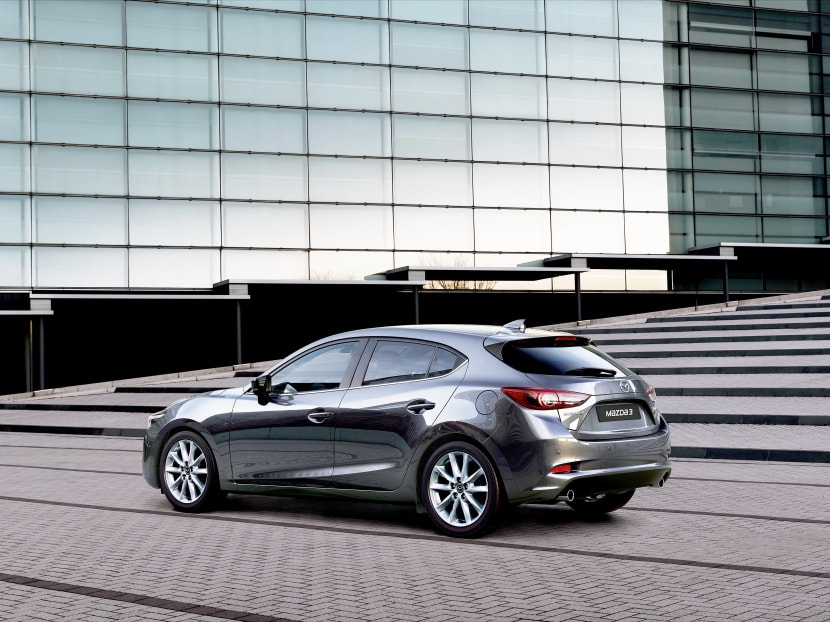Beneath the sheets: Why we love the updated Mazda 3
Yamaguchi Prefecture (Japan) — In its own words, Mazda considers itself a small player in the car industry — it sold 1,397,000 cars last year, compared to Toyota, which sold just over 10-million.

Mazda’s G-Vectoring Control technology makes the updated Mazda 3 handle even better. Photo: Big Fish
Yamaguchi Prefecture (Japan) — In its own words, Mazda considers itself a small player in the car industry — it sold 1,397,000 cars last year, compared to Toyota, which sold just over 10-million.
The car maker says that its approach to car design relies less on competitive product benchmarking, in contrast to what the big Japanese brands do. Instead, it tries to create offerings that reflect its car-making philosophy, which emphasises drivability, emotive design and clever use of technology.
That philosophy has been paying off as Mazda is on a roll: This year looks set to be its third straight year of record operating profits.
MAINSTREAM MAESTRO
Even its most mainstream car displays these traits clearly. The 3 is Mazda’s best-selling model. A small car available in sedan or hatchback form, it is the most popular offering from the Hiroshima-based brand in Singapore and around the world, accounting for one-third of its total global sales.
First launched in 2013 and now getting a major facelift, in true Mazda style it has gotten far more than just the regular mid-life nip-and-tuck.
The new hatch has the same chrome strip as before, but this now skirts the car’s front grille and is extended to form eyebrows, while the lower fog-light section has been cleaned up.
In the scheme of mid-life facelifts even that is minor. Driving delivers a polished, sorted experience rarely seen in a car that costs less than S$130,000.
On the inside, a newly-designed steering wheel and re-organised central console section make life easier, but to nail down what gives the 3 its sorted character isn’t one big thing, but many small ones.
VECTOR CONTROL
Luckily, Mazda made a big deal about its new driving assistance system, for it’s not likely the average driver will be able to tell, though it delivers tangible improvements.
It’s called G-Vectoring Control (GVC), and it’s quite different from existing systems that use the brakes of the inside wheel to help the car rotate in a corner (known as an electronic brake differential).
Instead, it works by measuring steering input and precisely varying the amount of torque the engine generates to match. This is a skill that has been mastered by the best pro-level drivers. For the rest of us, Mazda’s system works on a more granular level with computer control to modulate ignition and fuelling to reduce the engine output as required.
The system works at all speeds as long as steering and throttle input is active. We drove a car with the system switched on and off in identical conditions, and found the car much easier to drive in almost all situations. The steering needed much less steering correction, even in a straight line.
Although we did not test it in snow or rain, Mazda claims it also improves car stability in such situations.
The most visible benefits however, may not be in the driver’s hands at all. By smoothening out the entire drive in this manner, passengers are subjected to much less swaying, a key contributor to car-sickness, so theoretically GVC can make long journeys much less nauseating.
While it could be seen as a performance booster, Mazda isn’t selling it as one, but we think driving aficionados could get away with driving a little quicker in corners before being slapped on the wrist by his or her fellow occupants.
THE SUM OF ITS PARTS
Mazda will debut the system in this car as standard equipment, which launches next year, and gradually introduce it to the rest of the model range.
We drove the 2.2-litre turbodiesel variant, which like most oil-burners, is excellently frugal but also pleasingly fun to drive, thanks to its generous level of torque. A new 1.5-litre diesel has been added to the Mazda 3 line-up, though Singapore is most likely to receive the same 1.5 and 2.0-litre petrol engines found in the current car.
Compared to say, a new engine or drivetrain, the additions aren’t huge. But we should consider that the Mazda 3 was already a very complete package before this, and it shows the brand’s attention to feedback and detail that some of its larger rivals can’t match.
If there are any complaints, it’s that the Singapore will not receive the excellent diesels, which are now also quieter. The steering could also use more feedback to match its accuracy.
All in all, the Mazda 3’s incremental improvements are small but weighty.
It packs a clever surprise that most drivers will not notice, but will make the driving experience much smoother and safer for all occupants, without detracting from dynamics.
Mazda 3 2.2d Hatchback
Engine: 2,189cc, in-line four, turbodiesel, 150hp, 380Nm
Performance: 205kmh, 0-100kmh: s, 4.7L/100km, TBC g/km CO2 (performance data are estimates)
Price: TBC
On Sale: 2017
PROS: Handles even better, still a top-notch offering
CONS: No diesel models in Singapore, steering could be better





